We are going to try to use our weekends
- and Gerald's invitations to give talks/work with folks - to explore
other towns/areas in Germany and Europe. The train system is superb -
most towns/cities are accessible by train and the trains have been very
reliable. Our first venture was to Frankfurt. It is only about a
45 min train ride from Heidelberg and proved itself to be a fairly
straightforward way to break ourselves into the workings of the rail
system. It is also quite an interesting city. It is the
financial center of Germany and has some of the country's tallest
skyscrapers, but it also has a long history in trade and politics.
It was first mentioned in 794 (!) in a document signed by Charlemagne
and was involved with coronations during and after the "Holy Roman
Empire." John F. Kennedy also called it "the cradle of democracy in
Germany" because it hosted Germany's first parliamentary meeting in
1848. Most of the city (80%) was destroyed in WWII, but much of
it was rebuilt, as you can see below. The picture on the left is
the Römerberg - the old central square - with its restored 14th and
15th century buildings. On the right is one of the many
interesting pieces of art we saw in the Frankfurter Dom (the church
with the 95m/290 ft. tall steeple at the left of the Römerberg
picture). The Dom was actually left mostly standing after the WWII bombings,
and was built between the 13th and 15th century (the tower was completed in the 1860s).
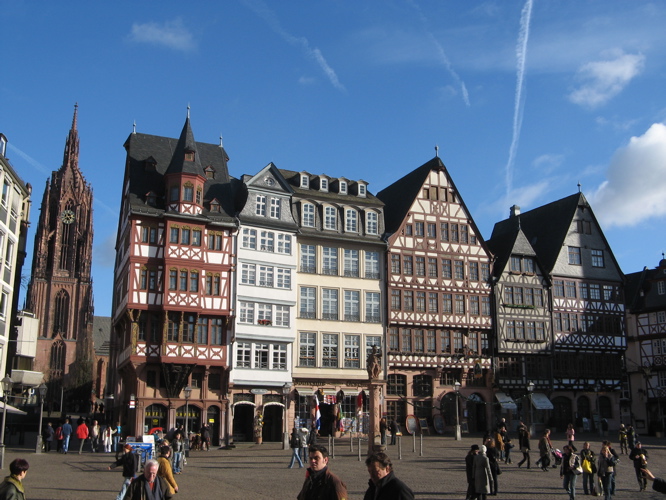
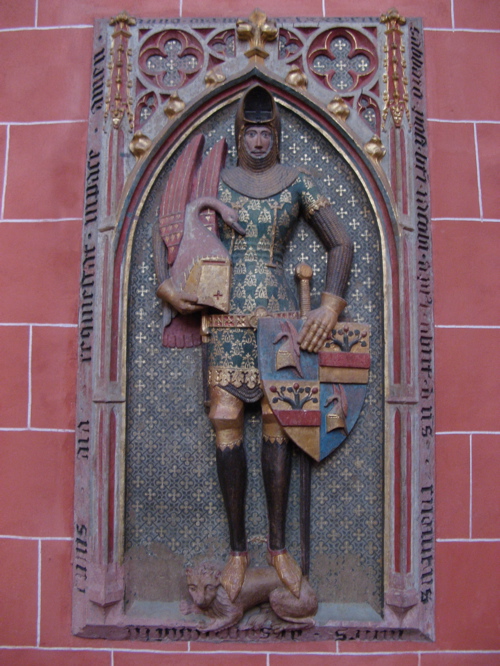
After walking around the town a bit and
touring the Dom, we visited the Museum of Modern Art. The museum's
building is fascinating. It was designed by Hans Hollein and is
wedge-shaped, with a maze of rooms and stairways inside (see below,
left). Neither of us was awed by most of the artwork, but the
building itself was worth the visit. Then we headed over the
Goethe Haus - the home of Germany's most famous poet,
Johann Wolfgang von Goethe. There was an excellent audio/PDA guide
that also had extra pictures on it (for example, the "innards"
of the upright piano forte they had in one of the rooms).
The house was much more lavish than we expected and very
interesting to explore. One of the highlights was the
astronomical clock pictured below that, in addition to the time and date, showed the
phases of the moon and zodiac signs. If you look at the bottom of
the "case" you can see a circus bear, inside the purple area. The bear
falls on his back as a warning that the clock needs winding!
Elyse has been inspired to read Goethe's "Faust". It's been
interesting so far!

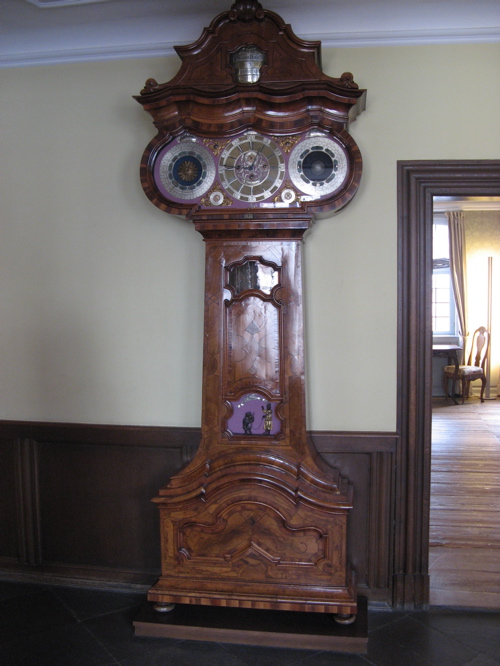
After a bite to eat (and a bit of a
rest), we headed over the river to the Städel Art Institute.
There were some fantastic pieces by the "old
masters" (Vermeer, Boticello and others), along with some more "modern"
artists (Manet, Renoir, etc.) as well. All in all, a very
impressive collection.
We stopped into the museum's book shop after and noticed a book
they had on an exhibit - at the sculpture branch of the museum down the
road (it was closed by then, but we wouldn't have had the energy to
explore it anyway!) - of the works of the Austrian sculptor, Franz
Xaver
Messerschmidt. The pieces looked great - we've copied an example from
the Internet below - and we were surprised to find out that he wasn't a
modern sculptor, but had actually lived from 1736-1783.
Definitely work we'd like to see in person at some point.
Reminiscent of Daumier's lithographic caricatures, but in
sculpture form.
When we came out of the museum, the sun was shining beautifully down
the river Main (pronounced mine), with a view of the Dom (again).
We decided to take a tram to explore some of the old quarter on
this southern side of city. We came across a traditional pub
serving the local apple-wine specialty, and decided to try it out (the pub - not just the wine) for
dinner. There were big wooden tables that people shared with
strangers and a lively, friendly mood; clearly a local favorite.
The apple-wine was very good. It wasn't sweet like cider,
but wasn't as dry as "grape" wine either. Very tasty!
They sold it in jugs with enough for 14 people, but we stuck to
the regular glasses (wimps that we are). The food was also very
good. Luckily, Elyse ordered a "light" meal that was enough to
feed us for 2 days! Gerald's schnitzel was falling over the sides
of his plate. All in all a nice way to end a great day.
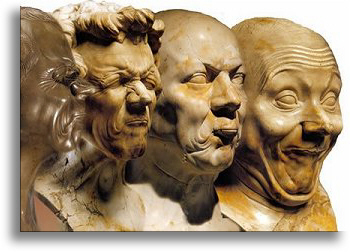
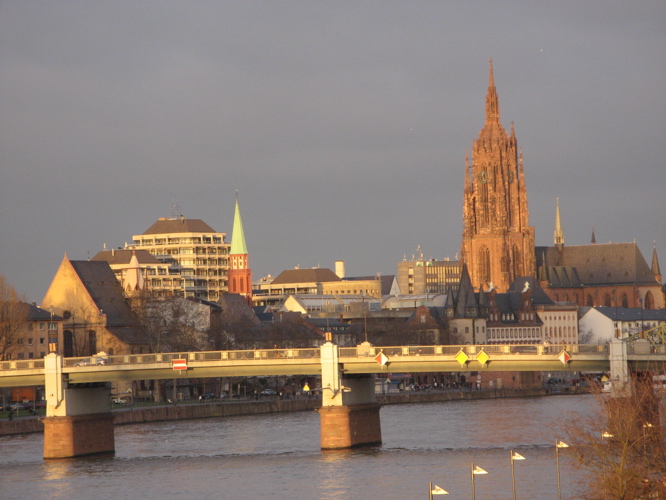
ERLANGEN / NÜRNBERG and surroundings
Gerald was invited to give a talk in
Erlangen (home of the university and a major site for Siemens), so we
decided to go in for the weekend before. Erlangen is only a 15 minutes
train ride from Nuremberg (strange transliteration from the German name
- where did the M come from??), and we knew there would be a lot to
explore. We arrived Saturday and were pleasantly surprised to
find what a beautiful town Erlangen is, with a few Huguenot temples
(their terminology for churches) and narrow, winding streets with nice old buildings
(see below, left). We went into Nuremberg for Saturday
afternoon/evening. We walked around the town and stopped into the
St. Lorenz Church (pictured below, middle - we couldn't fit the whole
thing into one picture!). St. Lorenz was begun around 1250 and
finished in about 1477. The inside is covered with incredible art
- sculptures, frescoes, woodwork - that just enhance its awesome size.
The clock on the right is on the Frauenkirche and dates from 1509
(the church itself is from 1350!). At noon, the seven figures you
can see glide out of the clock to come and "bow" before the figure of
Emperor Charles IV. In addition, the musicians surrounding the
central figures move and "play" their instruments. Quite
impressive - even worth standing in the rain to watch it!
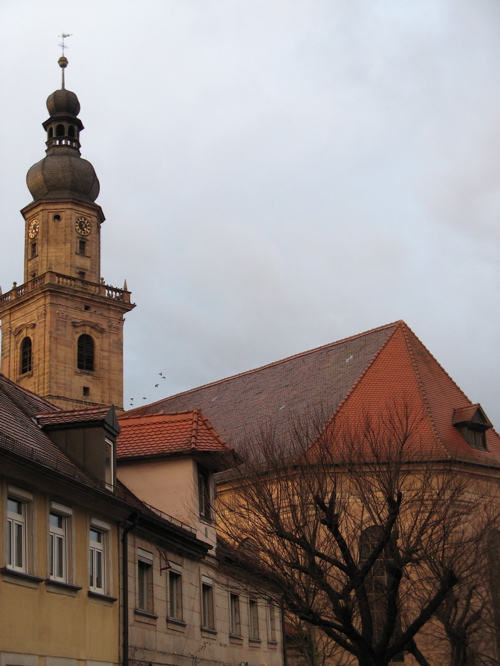
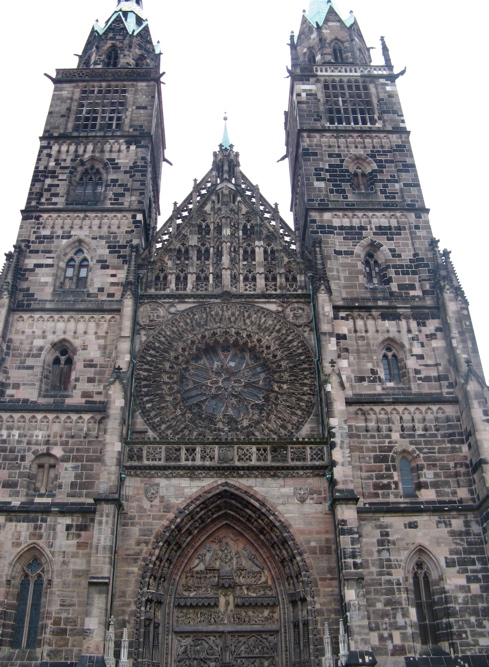
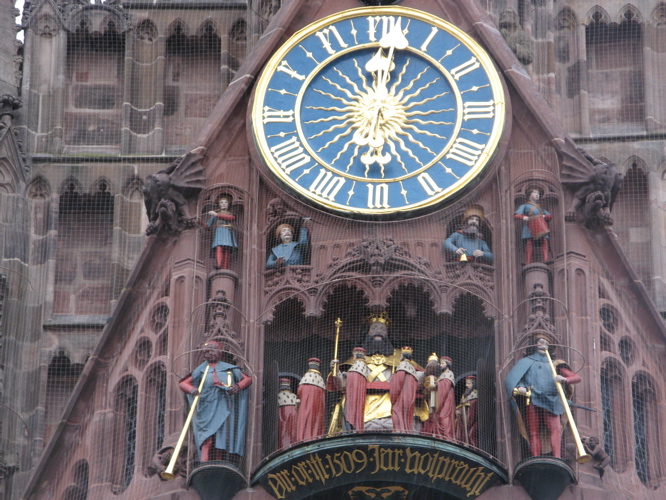
Our next stop was the Albrecht
Dürer House. The painter lived in this house from 1509 to
1528. They had a fascinating film that introduced us to his life
and his art. Not only did he create some incredible portraits and
intricate woodcuts, but apparently he was the first to do watercolors
(in Europe anyway). They had his workshop intact (with artists working
there on some days), including all the minerals and materials used for
the colors. The audio guide was superb, describing life in
general at that time as well as Dürer's accomplishments. We
had dinner in a restaurant/brewery set up in the old cellar rooms of a
grain customs warehouse. Gerald tried the local wurst
specialty (we have not even begun to distinguish among the
seemingly infinite variety of wursts in this country!). Elyse
took advantage of the fact that we are in a month with the letter "r"
to sample the carp specialty (apparently only available in these
months!). The fish arrived and was HUGE - curved up at the head
and tail ends - and delicious.
Sunday, we headed back into Nuremberg to visit the German National
Museum. It is the largest of its kind in Germany and is housed in
an old monastery. It has an impressive collection of art and artifacts,
including altarpieces and armor, and scientific and musical
instruments. We realized after we left (having spent 3 hours
looking around) that there was at least another half-day's worth of
things to see. One of our favorite parts was the collection of
musical
instruments. Apparently it started with a private collection that
had been donated to the museum and grew from there. We also
learned that the clarinet is an invention from Nuremberg! Not only did
the collection have pretty much every type of
piano imaginable, but there were strange and wonderful examples of wind
and string instruments as well.
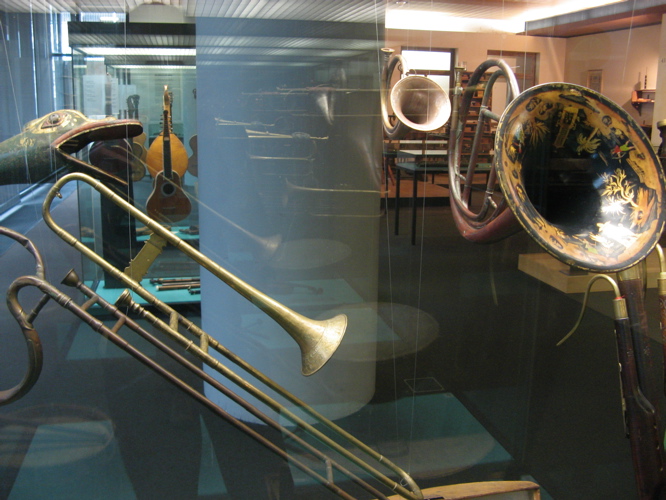
BAMBERG
We headed back to Erlangen after lunch
as Gerald's host had graciously offered to meet us there to take us to
nearby Bamberg for an evening tour and dinner. Bamberg is one of
the few towns in Germany that was not damaged much during the war.
Its main cathedral (Dom) is celebrating its THOUSANDTH(!)
birthday this year and was a very impressive place. It included
the simple, but touching tomb of Heinrich II (crowned Holy Roman
Emperor here in 1003) and his wife, sculpted by Tilman Riemenschneider
(well-known in these parts). There was a mass starting, so we
didn't wander around much. However, this did mean that we got to hear the organ in action. The Dom's surrounding residences and
buildings reminded us of the Vatican in (relative) size. Bamberg
itself is a picture-book medieval town, with half-timbered homes along
canals, narrow cobblestone roads and formal mansions along the river.
The Altes Rathaus (Old Town Hall, pictured below, right)
straddles the river (a ruse to avoid paying real-estate taxes,
apparently) and is incredibly ornate. Note in the picture, below
right, that a cherub's leg is sticking out of the mural just above the
rail/edge, about half-way across. The blue building is on the
other side of the bridge from the Rathaus. It was too dark to
take a lot of pictures around town, but we very much enjoyed walking
around. For dinner we went into a pub where Gerald tried the
local "rauchbier", which has a smoky flavor. It was a fun
evening.

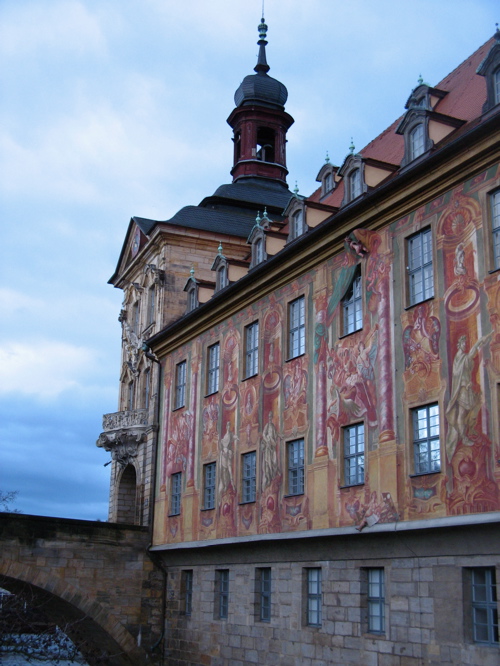
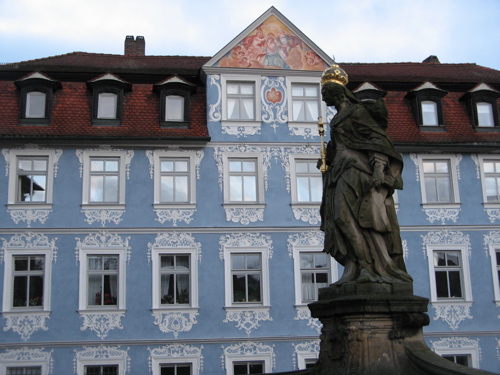
VIERZEHNHEILIGEN / BEYREUTH
While Gerald was giving his talk and
working that Monday and Tuesday,
his host's partner (Rachel) kindly offered to tour around with
Elyse. On Monday, they drove to a town about 20 miles away from
Erlangen to visit the
"Vierzehnheiligen" (Fourteen holy helpers/saints) church. This is
a
rococo-style church that was built in 1774 on the site
where a shepherd was supposed to have seen visions in the mid 1440s.
It is used as a pilgrimage site for many with various ailments
and there is a room filled with thank you notes and tokens, along with
discarded crutches, etc. Each of the saints has a "specialty"
ranging from headaches to health of pets to family discord.
Doesn't seem like an even division of labor to us ... But
the most striking thing about the
church is how incredibly ornate (WAY over the top for Elyse's taste)
the decor is in the church. We were not allowed to take pictures
of the inside, but here is one from the internet. The columns are not
marble, but stucco that has been polished to look like marble!
Impressive anyway.
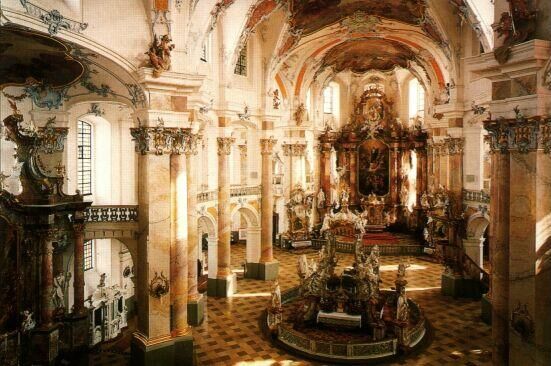
Our next stop was the town of Bayreuth (pronounced bye-roit)
where the composer Richard Wagner lived. There is an important
opera festival held here (held since 1876) every summer. We were
lucky
to find the house empty of tourists, so we were able to see the many
exhibits at a leisurely pace. Elyse probably would have gotten more out
of the visit if she were more familiar with Wagner's operas, but it was
still interesting. The (neoclassical) house was beautiful
and the exhibits included many examples of set designs and costumes,
along with letters and photographs of Wagner himself and important
people in his life (e.g., Franz Liszt was his father-in-law).
Also copies of his original scores and concert programs.
Apparently the music (and festival) were important for Hitler as
Wagner's music is very dramatic and is based on German mythology and
highlights its historical "strength",
fitting well into the Nazi view of the world. That evening we met
many of the physicists (faculty and students) for a pub meal in
Erlangen. A fun time.
On Tuesday, Rachel and Elyse headed to the Nazi Party Rally Grounds,
just out from Nuremberg's city center. By 2001, the town had
concluded its 50-year debate on what to do with the building(s) and had
converted the massive, half-finished Congress Hall (pictured
below) into a museum that houses the "Documentation Center" and a
permanent exhibit entitled, "Fascination and Terror". Hitler had
laid the foundation for this colossal building (designed to mimic the
Coliseum in Rome and to hold 50,000 people for meetings) in 1935.
There were plans for an 11 square kilometer/7 square mile complex
of buildings and grounds, planned by Albert Speer, that would be used
during Nazi Rallies to reflect the "power and glory" of the party.
Rallies had been held in Nuremberg since the late 1920's; the
city was apparently chosen as the site for these important symbols
partly because there had always been a lot of support for the National
Socialist (Nazi) Party in this area, and partly because the city had a
long history of imperial rule (the rally grounds were designed to line
up with the castle in the background), which reinforced Hitler's
desire to be viewed as building an empire.
Elyse hadn't realized Nuremberg's importance in the rise and power of
the Nazi's; it was strange to see sites in the archival footage that
she and Gerald had just visited on the weekend. The
exhibits and filmed interviews explained the rise and impact of the
Nazi Party (and the Nuremberg trials) very clearly and effectively.
Rachel surprised Elyse by buying her the book of the museum (in
English, no
less!), so Elyse will have that as a reference as the detailed memories
fade. The book also explained the design of Austrian architect,
Günther Domenig for the glass/steel "spear" that pierces the hall
at an angle and houses the exhibits. If anyone would like to see more
about the museum online, the address is:
http://www.museen.nuernberg.de/english/english/reichsparteitag_e/index_reichsparteitag_e.html.
It was a disturbing place - as are all the monuments of this
horrible period - and a stern reminder of the dangers of
propaganda/media hype and a culture based on fear, power and excessive
nationalism. Potent lessons for today as well, unfortunately.
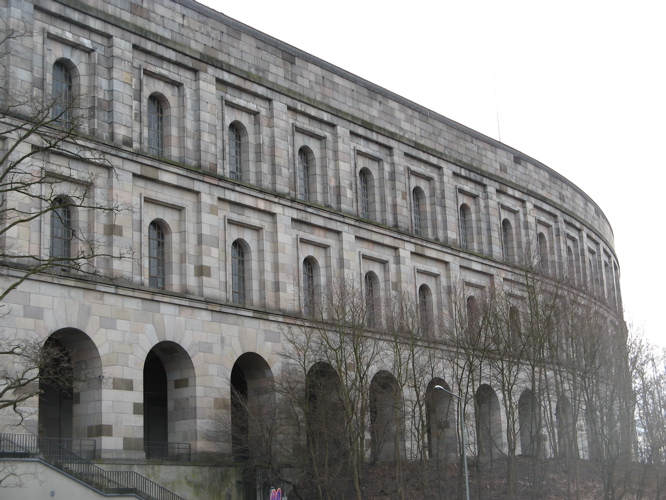
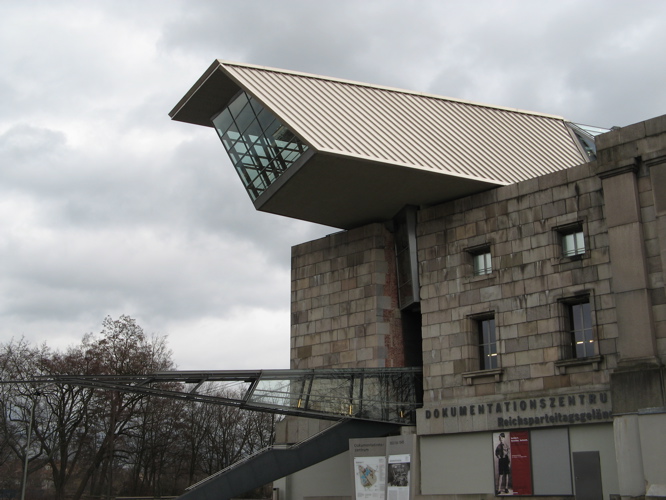
Gerald had had a productive and successful visit
at the University in Erlangen and we had managed to fit a lot into a
few days. But it was nice to get on the train after dinner and
head back "home" to Heidelberg.

